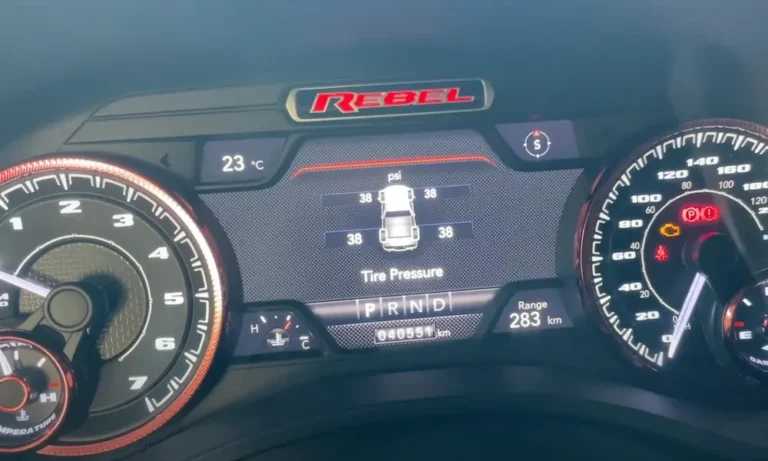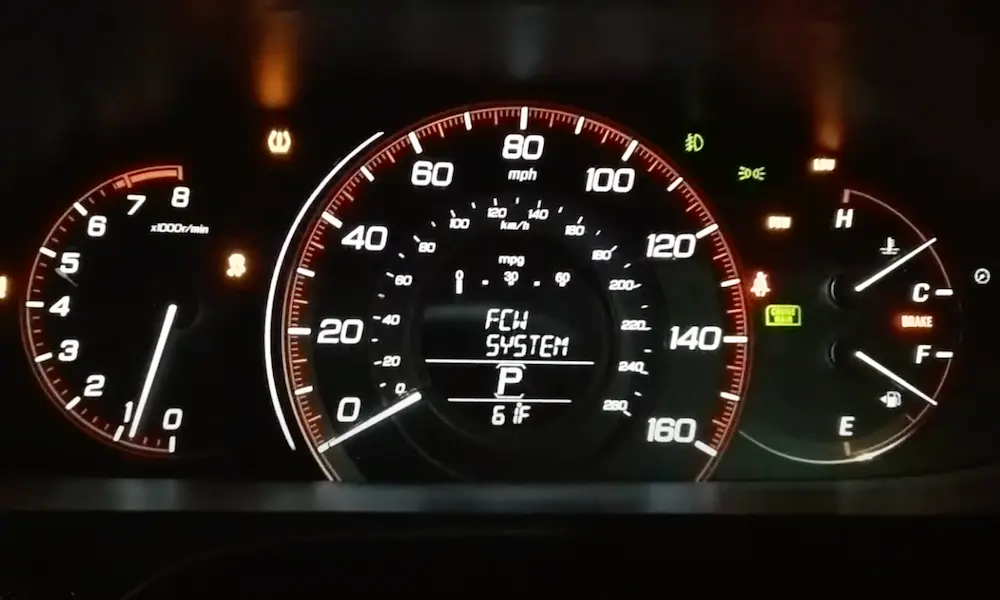Getting that annoying tire pressure light to turn off in your Ram 1500 can feel like solving a puzzle. If you’ve already filled your tires properly but the warning persists, you’re likely dealing with sensors that need resetting. The good news? You can often fix this yourself without a trip to the dealership. This guide walks you through every method to reset your Ram 1500’s tire pressure monitoring system (TPMS).
What Exactly is the Ram 1500 TPMS System?
Your Ram 1500 uses a direct TPMS system with sensors installed inside each wheel that constantly measure tire pressure. When pressure drops about 25% below the recommended level, these sensors trigger that warning light on your dash.
Depending on your Ram’s model year and trim level, you might see:
- A simple warning light
- Individual pressure readings for each tire
- Messages on your information display
The system isn’t just about convenience—it’s a safety feature that helps prevent blowouts, improves fuel economy, and extends tire life.
Why Your TPMS Light Stays On (Even With Proper Pressure)
Before attempting any reset procedures, understand why your system might need resetting:
- Temperature changes (cold weather often triggers warnings)
- Recent tire rotation or service
- New tire installation
- Battery replacement or disconnection
- Sensor battery failure (they typically last 5-7 years)
Simple Reset Methods for Ram 1500 TPMS
Method 1: The Button Reset (2019+ Models)
Many newer Ram 1500s have a dedicated reset button that makes this process quick:
- Turn ignition to “ON” position (don’t start engine)
- Locate the TPMS reset button (usually beneath the steering wheel or in the glove box)
- Hold the button until the TPMS light blinks three times
- Start the engine
- Drive for 20 minutes to complete calibration
This works particularly well on 2019 and newer Ram 1500 models, though button location varies by model year.
Method 2: The Driving Reset Method
If your Ram doesn’t have a reset button, try this pressure-and-drive approach:
- Check the driver’s door jamb for the correct PSI levels
- Inflate all tires to the recommended pressure (add 3 PSI extra for cold weather)
- Drive at highway speeds (around 50 mph) for 10-20 minutes continuously
- The system should recalibrate automatically and turn off the warning light
For most Ram 1500s, especially 2015-2022 models, this driving method works because the system needs time at consistent speeds to take new readings and update.
Advanced Reset Procedures for Stubborn TPMS Lights
Method 3: Auto Relearn Procedure (Works for 2008-2020 Models)
If the driving method didn’t work, try this more structured approach:
- Make sure all tires are properly inflated to the exact recommended PSI
- Start with a complete ignition cycle (OFF → ON → OFF)
- Turn ignition to ON again (don’t start engine)
- Drive continuously for 15-20 minutes at speeds above 15 mph
- Make several gradual turns during your drive (this helps sensors communicate)
- The light should eventually turn off after the system completes its relearn cycle
Method 4: Battery Disconnect Method
Sometimes the system just needs a complete reset:
- Open the hood and locate the battery
- Disconnect the negative (black) battery terminal
- Press and hold the horn button for 5 seconds to drain residual power
- Wait 10-15 minutes
- Reconnect the battery
- Start the vehicle and check if the TPMS light resets
This method forces all computer systems to restart, which can clear persistent TPMS errors.
Using Professional TPMS Reset Tools
OBD Reset Method (Technical Option)
For those comfortable with more technical approaches:
- Purchase or borrow an OBD-II scanner with TPMS function capabilities
- Connect the scanner to your Ram’s OBD port (under the dash near steering column)
- Navigate to the TPMS menu on the scanner
- Select “TPMS Reset” or “TPMS Relearn”
- Follow the on-screen instructions (typically involves activating each sensor)
This method is particularly effective for 2008-2017 Ram 1500 models that require a more formal relearn procedure.
Ram 1500 TPMS Sensor Replacement Guide
If your sensors are failing (typically after 5-7 years), replacement might be necessary:
When to Consider Sensor Replacement
- TPMS light flashes for 1-2 minutes before staying solid
- System shows obviously incorrect pressure readings
- Light remains after multiple reset attempts
- Recent tire service with TPMS warnings immediately after
Sensor Replacement Options
- Dealer replacement: Easiest but most expensive ($75-120 per sensor)
- Tire shop replacement: More affordable ($40-80 per sensor)
- DIY replacement: Cheapest but requires special tools and knowledge
When replacing sensors, ensure they’re programmed for your specific Ram model year. Ram changed sensor frequencies in mid-2009, with newer models using 433MHz sensors.
Special Considerations for Modified Ram 1500s
Troubleshooting TPMS with Aftermarket Wheels
Lifted Ram 1500s with aftermarket wheels often experience TPMS headaches:
- Signal interference: Larger wheels can block sensor signals
- Pressure thresholds: Stock settings don’t match larger tire requirements
- Sensor position: Aftermarket wheels may position sensors differently
Reprogramming TPMS Thresholds for Larger Tires
If you’ve upgraded to 35″ or larger tires that need different pressure settings:
- Use an Alfa OBD app with compatible OBD reader
- Connect to your vehicle’s computer
- Navigate to “Body Computer” settings
- Find “Update Pressure Thresholds”
- Adjust front/rear pressure values for your new tire specifications
This programming adjustment is crucial for Ram 1500s with significant tire upgrades that run at lower pressures than stock settings.
Complete TPMS Reset Protocol for Different Ram 1500 Model Years
2014-2018 Ram 1500 Models
- Ensure all tires are at recommended pressure (check driver’s door jamb)
- Start vehicle and drive continuously for 15+ minutes at 15+ mph
- Make several gradual turns
- If light remains, try the battery disconnect method
2019-2023 Ram 1500 Models
- Locate TPMS reset button (usually near steering column)
- With ignition ON (not started), press and hold until light blinks
- Start engine and drive for 10+ minutes
- System should reset automatically
Troubleshooting Common Ram 1500 TPMS Problems
Intermittent TPMS Light Issues
If your light comes on in cold weather but disappears when warmer:
- This is normal sensor behavior
- Add 2-3 PSI in winter months to prevent warnings
- Consider programming seasonal thresholds if you live in extreme climates
Individual Tire Reading Errors
If one tire consistently shows incorrect readings:
- Check that specific tire’s pressure manually
- Try repositioning the valve stem (sometimes sensors get stuck)
- Consider that individual sensor may be failing
Complete System Failure
If your system shows “Service TPMS” or “TPMS Unavailable”:
- Check for recent electrical work or battery issues
- Scan for error codes with an OBD-II reader
- The module itself may need dealer service
Understanding Ram 1500 TPMS Error Messages
| Error Message | Likely Causes | Solution |
|---|---|---|
| “Tire Pressure Low” | One or more tires below threshold | Inflate tires to proper PSI |
| “Service TPMS” | System malfunction or module failure | Professional diagnosis needed |
| “TPMS Unavailable” | Vehicle systems can’t communicate with sensors | Try battery disconnect method |
| Flashing TPMS Light | Sensor battery low or failing | Likely needs sensor replacement |
Seasonal Tips for Ram 1500 TPMS Function
Winter TPMS Management
Cold weather dramatically affects tire pressure. For every 10°F drop, tires lose about 1 PSI. To prevent winter TPMS warnings:
- Check pressures monthly during winter
- Consider setting pressures 2-3 PSI higher than door recommendations
- Let tires warm up before making pressure adjustments
Addressing Summer Heat Issues
High temperatures can cause pressure increases that affect handling:
- Check pressure when tires are cool (morning is best)
- Don’t reduce pressure when tires are hot from driving
- Recalibrate TPMS if relocating from cold to hot climate long-term
Preventative Maintenance for Reliable TPMS Function
Extending TPMS Sensor Life
While sensors typically last 5-7 years, you can maximize lifespan:
- Use metal valve stems instead of rubber when replacing
- Apply anti-corrosion compound to valve stems annually
- Be cautious with tire sealants (some damage sensors)
- When mounting tires, ensure techs use proper TPMS service kits
Regular TPMS System Checks
Incorporate these into your routine maintenance:
- Test sensor function during seasonal tire changes
- Have battery levels checked during tire rotations
- Update sensor programming when available from dealer
Final Thoughts on Ram 1500 TPMS Management
The tire pressure monitoring system in your Ram 1500 is more than just another dashboard light—it’s an early warning system that can prevent blowouts and save you money on fuel and tires. Most reset issues can be resolved with the methods outlined here, but don’t hesitate to seek professional help for persistent problems.
Remember that TPMS sensors are consumable items with limited battery life. If your truck is approaching the 5-7 year mark, consider proactive sensor replacement during your next tire change to avoid unexpected failures on the road.














